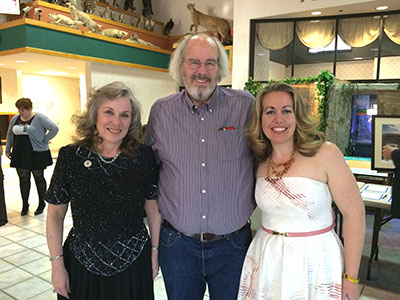FHSU speaker envisions 'dinochicken'

04/05/16
By Randy Gonzales
University Relations and Marketing
HAYS, Kan. -- If world-renowned paleontologist Dr. Jack Horner makes a return trip to Fort Hays State University, who knows -- he might have a "dinochicken" in tow if everything goes according to plan.
Horner, curator of paleontology at the Museum of the Rockies and Regents professor of paleontology at Montana State University in Bozeman, gave a lecture Friday night at FHSU's Beach/Schmidt Performing Arts Center about the past, present and future of dinosaurs.
Horner also was a special guest at a Saturday night fundraiser for FHSU's Sternberg Museum of Natural History, where one of his former students works.
"For me, it's very exciting because he's been such an important mentor for me," said Dr. Laura Wilson, assistant professor of geosciences at Fort Hays State and curator of paleontology at Sternberg. "I get to share that with a community I'm a part of now."
Wilson, who grew up in Georgia, went on summer vacations to Florida where she could experience firsthand her early love -- sharks.
"I fell in love with 'Shark Week' back when it had real science," Wilson said of the summer TV series. "My dad and I would get up early in the morning and collect sharks' teeth on the beach."
Wilson's interest evolved from marine biology to paleontology, a path that led to Montana State -- and Horner. He was Wilson's master's advisor.
Horner has been a technical advisor for the "Jurassic Park" movies and was partial inspiration for one of the leading characters. Horner said both he and director Steven Spielberg had no idea the films would become so popular.
"People hadn't seen many dinosaur movies," Horner said. "We thought the chances were pretty good but we never had any idea they would be so big."
It has become accepted that birds are descendants of dinosaurs, and that is where Horner's work is focused.
"It's basically genetic engineering," Horner said. "We know that birds are their descendants, and we know we can retro-engineer a bird to look like a dinosaur. We're working on it. As long as evolution works, it works."
The chicken has been chosen as the subject, with its embryo the key. Work on the project has stalled at making a tail; it has proven a more difficult task than originally anticipated.
"We've figured out how to grow a tail," Horner said. "What we haven't figured out is how to stop a tail from growing.
"Right now our experiments are to initiate growth but stop it at the right time," he added. "That is our biggest obstacle right now."
The "dinochicken," as Horner called it Friday, will not be hatched before its time.
"We will never hatch anything until what we think our animal should look like hatches," Horner said.
Horner's appearance was part of a fundraiser for improved facilities at Sternberg.
"The ultimate goal is a new fossil preparation lab at the museum," Wilson said, "by turning the small facility we have into a hands-on classroom."
Perhaps one day, 15-year-old Bryan Williams will be in one of those classrooms.
Williams and his parents, Aaron and Megan Odegard, drove from Olathe to hear Horner speak. Bryan's parents said he has toured Sternberg at least a dozen times. Bryan, who attends high school at Olathe North, is part of a specialized education program geared toward geosciences. He was in awe of Horner's lecture.
"It completely changed what I thought about dinosaurs," he said.
Bryan's father, a Fort Hays State graduate, learned of Horner's lecture on the university's website. He knew it was a must-see for his family. His wife was trying to wrap her head around the idea of a "dinochicken."
"That would be trippy," she said.
After an hour lecture, Horner answered questions from young and old alike for another 45 minutes.
"I'm a professor. I'm an educator," Horner said. "My whole job is about education. I enjoy the fact people are interested."